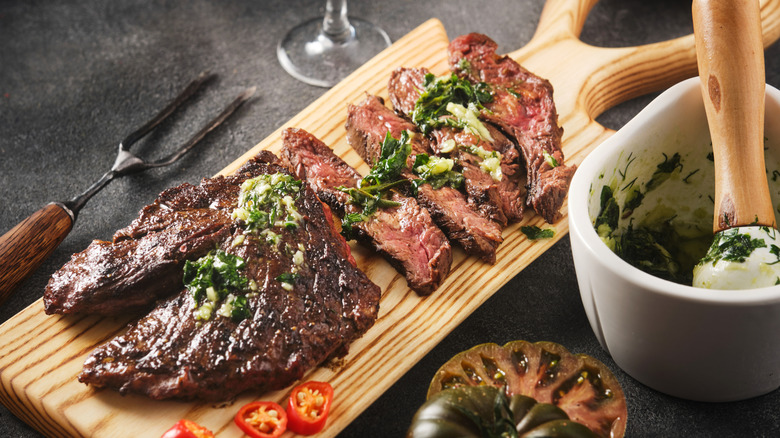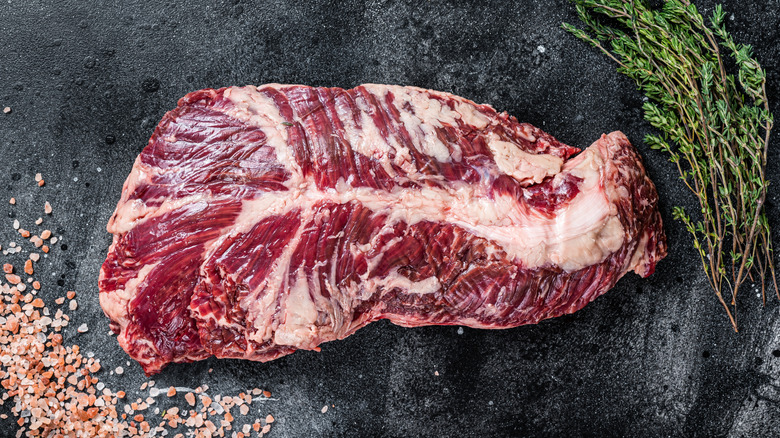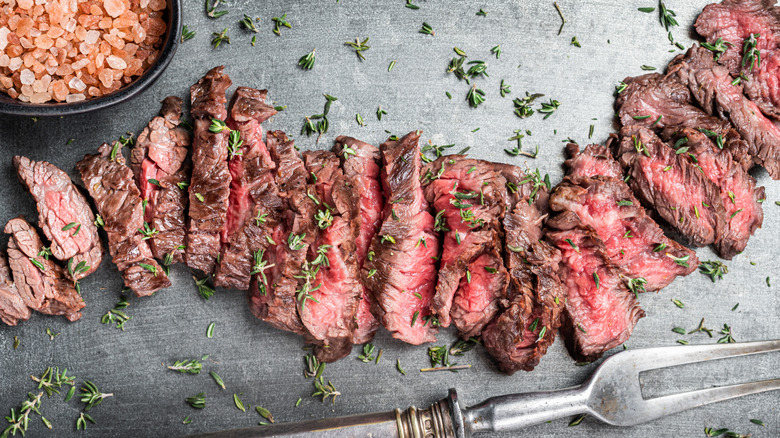Hanger Steak Vs Skirt Steak: What's The Difference?
A beef carcass from a single cow has more than 200 muscles, resulting in nearly 640 pounds of edible meat. While most people are familiar with prized steaks often seen on restaurant menus such as filet mignon or a New York strip, there are many cuts of beef that are less popular but can be mouthwateringly tasty if prepared correctly. Hanger steak and skirt steak both fall into that category, as they have been through their respective periods of being considered "undesirable." They look somewhat similar, and both come from the beef plate — or front, lower belly. They are leaner than ribeyes or porterhouses, which are known for their high-fat content, but since the plate is not an overworked part of the cow, both cuts have a reasonable amount of fat that gives them a bold, beefy flavor. However, the plate contains a lot of connective tissue, which is why one wrong preparation move can result in tough and chewy meat that ruins your dish.
However, don't turn your nose up at these cuts if you see them at a butcher's counter. If you know how to properly cut, season, and cook them, they are tender and delicious. In fact, skirt steak is often the beef cut of choice for sizzling fajitas at restaurants, and hanger steak is prized by butchers. The latter has even earned the nickname "butcher's steak" because it was the cut they would keep for themselves. Even though skirt and hanger steaks come from the same area of the cow and possess some similarities, it's also important to understand their differences so you can make the best choice for whatever dish you're creating.
What is hanger steak?
Hanger steak is a rarer cut because there is only one per animal. It literally "hangs" from the diaphragm of the cow, hence its name. Hanger steak is a flat cut that weighs about a pound and looks like a V. It has a tough sinew running right through the middle of it. When preparing this cut, you'll want to cut this membrane out, separating it into two separate pieces of steak, though a butcher can certainly do this step for you.
Marinating a hanger steak for as long as possible — up to 24 hours — will improve the tenderness, texture, and obviously, the flavor of your steak. To avoid the meat becoming tough, you'll want to cook it hot and fast to a medium-rare temperature. A quick pan sear or grilling over intense, high heat will yield the best results. Hanger steak has prominent muscle fibers running through it, so after resting the steak for a few minutes, ensure you slice it against the grain for the most tender results.
What is skirt steak?
Skirt steak is long, flat, and thin, coming in at about ½ inch of thickness. Each cow has four skirt steaks — two inside and two outside. The inside skirt steak is more tender, but both taste rich and beefy. Meanwhile, thin, skirt steaks can be surprisingly long, measuring up to 24 inches. The texture of skirt steak is coarser than hanger steak with very obvious muscle fibers. And remember, there is a right way to cut a skirt steak to avoid toughness that totally ruins the meat. Ensure you are slicing it thinly against the grain if you don't want to end up chewing one bite forever.
The coarse texture makes it an excellent candidate for bold marinades, and the longer you let it linger with those other flavors, the better. Like hanger steak, skirt steaks are best cooked quickly over intense, high heat. Your goal here is for the outside to have a nice, crusty sear, and for the inside to be a perfect pink, medium-rare. This cut is very popular in Latin American cooking, so if you're making fajitas or tacos, pick up some skirt steak. It's always a good candidate for anything requiring a saucy marinade, so it would work well in Asian stir fries or noodle dishes as well.
Both hanger and skirt steak offer incredible flavor, especially for dishes that call for bold flavors. Hanger steak is a bit more expensive than a skirt steak — just given that there is only one of the former per animal — but both of them are flavorful pieces of beef that won't break the bank.


